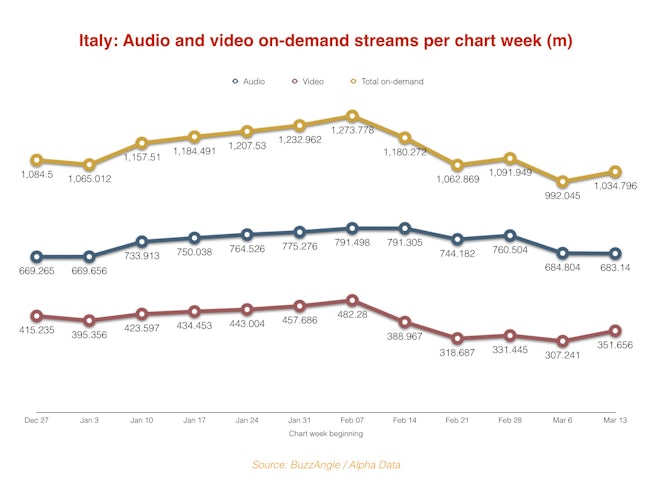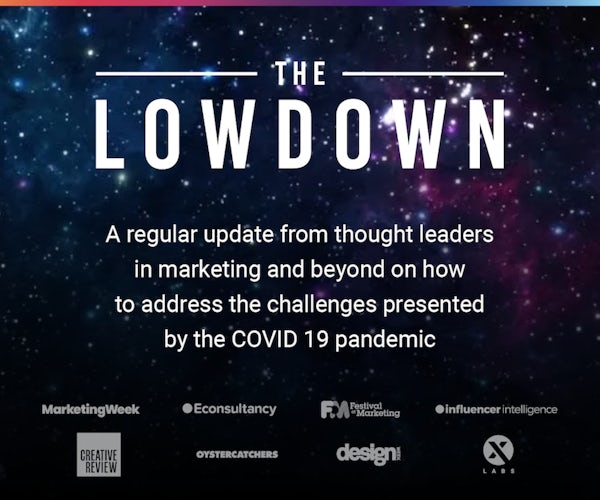The music industry is so intrinsically linked with large audiences and live experiences, and when the seriousness of the outbreak became evident, the industry had to act quickly.
A whole year of festivals, gigs and tours has been thrown into doubt as the world is at a standstill for the foreseeable future.
As such, I’ve looked at how the music industry has been affected by the coronavirus outbreak and what it’s doing to keep fans entertained whilst they practice self-isolation and social distancing.
People are doing less music streaming
Perhaps surprisingly, Music Business Worldwide found that global streams from Spotify’s Top 200 chart dropped 11% to 226 million plays in the week commencing March 13 (music weeks run from Friday to Thursday).
March 13th is significant to note as this is when a number of countries around the world followed the rest of the EU’s lead and began shuttering shops, bars and closed colleges, schools and nurseries, forcing people to practice social distancing and stay indoors.

Interestingly, the week commencing March 13th represents the lowest number of streams globally since the last week of 2019 and the first week of 2020 (n.b. these two weeks are noted to be the music industry’s down period, where releases dry up and people are off work).
Video streaming booms amidst changing habits
BuzzAngel and Alpha Data looked into audio streams in Italy (the country currently experience the highest number of coronavirus victims).

The data shows that audio streaming numbers were down 10% March 6th from the week prior, and that video streaming saw a spike of around 14.5% in week commencing March 13th, perhaps indicative of a change in consumer behaviour.
In other words, with fewer people commuting to work and choosing video streaming platforms over music.
Interestingly, in a similar time period, Netflix has reforecast its year-on-year subscriptions growth and Amazon-owned Twitch has seen its viewership grow 31% from 33 million to 43 million (March 8th to 22nd), further highlighting these short-term changes to consumer behaviour.
In terms of sales figures, the picture doesn’t appear to be any better with physical album sales (-27.6%), digital album sales (-12.4%), and digital single sales (-10.7%) all experiencing a similar slump to streaming platforms.
Streaming platform Deezer also reported a slight change in its users’ listening habits, with its daily spike in listeners shifting from rush-hour (7am) to between 9am – 10am.
It’s not all doom and gloom though. With an increased interest in what’s happening around the world, music lovers have been using Spotify’s COVID-19 Hub (part of its COVID-19 Music Relief Project) to tune into specially curated playlists and news podcasts to stay informed whilst using the streaming platform.
Today, we’re launching the Spotify COVID-19 Music Relief project, matching donations up to $10 million. Read on for more about this and all our global efforts since the onset of the pandemic. https://t.co/AguWnZHEHn
— Spotify News (@SpotifyNews) March 25, 2020
The world tunes in to radio
People’s desire to stay informed is also reflected by digital radio’s performance during the coronavirus outbreak.
According to the BBC, it saw its own radio properties boast a streaming increase of 18%. This is similar to reports from Global (which owns Capital FM and LBC 97.3) which saw a 15% increase in online radio streams between March 9th and 17th.
Global also reported that consumers accessing its radio stations, through smart speakers, was up 11% – its highest ever weekly increase. What’s more, DAX (Global’s digital advertising exchange) reported that Alexa flash news briefings were also up 156%.
LBC’s daily reach grew by 43% and Heart (Global’s biggest commercial radio station) saw its daily audience increase by 11%, with Smooth Radio’s playlist reach increasing by 12% also.
With so much cooking going on, and people also desperate for news and coverage of the current situation, it shouldn’t come as a surprise that radio stations are experiencing this kind of uplift.
The story is even more compelling in the US, according to Entercom Communications Corps SVP of Product John Pacino.
Pacino told the L.A. Times that listening was up as much as 44% week-on-week (55% up on the two-week average) on one of Entercom’s radio stations, KNX.
Similarly, US radio conglomerate, iHeart Radio, has also seen an increase in its key engagement metrics. iHeart’s chief programming officer, Tom Poleman, noted a significant increase in digital measurements showing increased usage of iHeart Radio across smart speakers (30%), its smart TV app (22%) and its website (20%).
Poleman also shared that social media engagement on iHeart Radio content, shared by its radio personalities, was also up a massive 97%.
Live Events
Given the nature of coronavirus, and how it spreads, live music, concerts, festivals and large gatherings were some of the first events to officially be postponed and cancelled following the pandemics proliferation.
For instance, in the UK, there has been a ban on mass gatherings of more than 500 people in place since March 16th.
Huge international festivals such as Glastonbury – which was heading into its 50th birthday – have been cancelled and L.A.-based festival Coachella has been postponed until October, in order to mitigate large crowds of people and control the spread of the virus.
— Coachella (@coachella) March 10, 2020
However, it’s isn’t just the mega festivals and events that are being affected by COVID-19, smaller indie festivals are also being hampered by the virus.
The Association of Independent Festivals (which owns Field Day) have already reported a 44% dip in year-on year ticket sales from its members – with 92% of people citing coronavirus as impacting their decision.
Similarly, Music Venue Trust reported a 27% drop in UK venue attendance figure already this year so far.
The story is the same in the US, with music companies like Live Nation and AEG suspending all tours.
With all the cancellations and postponements, artists have had to think of creative ways to interact with their fans in the global down period.
Take American musician Swae Lee for instance, who decided to host his own concert from the confines of his studio on Instagram Live.
The concert received a lot of positive reactions on social media and has subsequently been uploaded to Swae Lee’s YouTube channel for fans to enjoy on-demand.
There was a similar performance by pianist Igor Levit, who also took to social media to share a live half-an-hour concert with fans on Twitter and Periscope.
<—— glücklicher, dankbarer Mensch. Danke Euch. Von Herzen. Danke. Alles sehr, sehr besonders für mich.
Danke.Feeling blessed and happy. Thank you. All of you. From the deepest of my heart. Thank you.
???????? https://t.co/rsPrf11b7B
— Igor Levit (@igorpianist) March 25, 2020
Interestingly, Levit isn’t the only classical musician with the idea as a number of operas and musicals will still be taking place from homes and empty concert halls, according to reports from The Guardian.
Another innovative use of Instagram Live from the music world comes in the form of live battles. These battles are essentially shared Instagram Live streams between two artists who go back and forth sharing their biggest and favourite hits.
The first battle premiered was between music producing legends Timbaland and Swizz Beatz, but has since included other popular artists and songwriters like Ne-Yo and The-Dream, and superstar producers Boi1da and Hitboy.
Supporting artists and creatives
With concerts and festivals postponed at best (and canceled at worst), and streaming numbers down globally what’s being done to supplement artists that are potentially losing out on tour and streaming revenue?
Bandcamp was one of the first companies to make a push to support artists by temporarily waiving its revenue share on Friday 20th March, and allowing any money spent on the platform to be distributed directly to the artist.
To support musicians during the Covid-19 pandemic, Bandcamp is waiving our revenue share on all sales this Friday, March 20, from midnight to midnight PST.
Read more here: https://t.co/hPhgm7WBR4 pic.twitter.com/HDyjdvBQet
— bandcamp (@Bandcamp) March 17, 2020
The aforementioned COVID-19 Music Relief Project by Spotify aims to supplement artists with important resources and financial support and information they will need should they experience a major loss in income due to coronavirus.
Spotify also pledges to match, dollar-for-dollar, the amount of money raised by the public – up to a maximum of $10 million, with acceptance of public donations for COVID relief charities,
The donations feature, that currently sites on its website, will be extended to artists pages on Spotify where they will be able to accept donations for a cause or charities of their choice.
Not wanting to be completely outdone by its closest competitor, Apple Music recently launched ‘Come Together’ which will host a number of playlists, music videos and Beats 1 Radio selections to help people get through the testing times.
"Coming together as one I hope will be the result of this." @eltonofficial connects with @zanelowe to share his favorite songs and talk life at home. Listen: https://t.co/8q7KcuIiLp pic.twitter.com/bsS0J1vWIA
— Beats 1 (@Beats1) March 28, 2020
And at the smaller end of the scale, Apple is giving its customers 90-days free access to both Final Cut and Logic Pro to encourage people interested in harnessing their creative powers during the outbreak to get editing and producing visual and audio content.


Comments